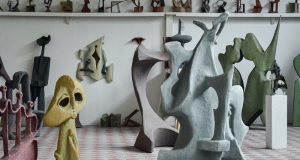A new exhibition reveals the artist Elisabeth Frink at her menacing, macabre best.

Mirage I, 1969, and Mirage II, 1969, by Elisabeth Frink
The bird perches on its pedestal: a raven, perhaps, or crow; or maybe some sort of raptor. It stands, alert and watchful, shoulders hunched, neck stretching. Its beak is a weapon. It looks menacing. It stalks the mind like a scavenging metaphor; like death keeping guard of our bones.
This is the sculpture that established Elisabeth Frink. She was 22 years old and still an art student at Chelsea when the Tate invested in her 1952 Bird. The following year she was picked out of a field of about 3,500 artists from all over the world when her entry to a competition to sculpt a monument for “The Unknown Political Prisoner” was deemed worthy of special mention. And although her maquette of a figure with a hawk on its wrist was not the eventual winner (nor, in fact, did the winning work — by Reg Butler — ever get made), her reputation was pretty much secured.
She brought to bear on her work an unsentimental love of nature
For the next two decades, Frink produced pieces that spoke strongly to a postwar generation. She understood viscerally what the world had been through. Her father was a career soldier who fought at Dunkirk and she, living at the time in rural Suffolk, a wild little girl who loved galloping on horseback, was not yet in her teens when she saw the damaged bombers crash-landing in flames on to a neighbouring RAF field. Sent away to board at a convent in Devon, she once had to flatten herself in the hedgerows to escape the strafing of a German fighter attack. Later, aged 15, she sat rooted in horror as the local cinema screened the first news footage of the liberation of Belsen.

Goggled Head II (teeth), 1969, by Elisabeth Frink
Frink’s work sprung directly from such childhood experience. She brought to bear on her work a profoundly unsentimental love of nature and what was to become a lifelong preoccupation with conflict and the human capacity for violence and cruelty. She sculpted macabre avians with wings armoured like warplanes; menacing beasts that loped, stalked and slouched; ravaged human figures and the flayed heads of horses; and a famous series of goggle-eyed busts.
A representative selection of about fifty of these pieces, gathered in thematic huddles, ranging in size from the monumental to the maquette and displayed alongside the drawings in which they find their eloquent beginnings, are now on show in an exhibition at Hauser & Wirth, Somerset. Transformation focuses on Frink’s sculpture from the 1950s and 1960s, the decades in which she established both her trademark themes and her fame. Man and beast mingle. Mythical stories and spiritual messages (arising from but not directly reflective of her Roman Catholic upbringing) find physical expression. The primitive and the futuristic, the primal and the apocalyptic merge. The traditionally figurative is balanced with modernist abstraction. Vulnerable fragility and brutal ferocity meet.
It is easy to understand why Frink proved so popular. The art historian can find her influences in Giacometti’s stilted striders; contemplate the impact of Jacob Epstein’s robotic Rock Drill; discover a debt to Henry Moore (it is technical rather than stylistic — applying wet plaster on to her metal armatures, she carved directly into the damp surface); or study her in the context of her postwar colleagues: a group of sculptors, including Butler, Bernard Meadows and Eduardo Paolozzi, who were commonly dubbed the Geometry of Fear School. However, the viewer need not know anything about the academic backstory to feel the physical presence and the visual force of these pieces.
Frink captures a crux point — the transformational moment of this show’s title — which stirs visceral feelings. A dead hen, cast in bronze, lies as if dumped on a plinth. Stiff-legged, curl-toed and horribly contorted, it conjures up images of corpses abandoned in concentration camps. A fascination with flight is expressed in a grouping of spindle-legged figures that, unfurling fledgling feathers or sprouting lumpen wing stumps, sometimes manage to skim but never quite to soar. These were inspired by the 1956 attempt of a Frenchman to take to the air on wooden wings and also draw on Frink’s wartime memories of crashed planes. But at the same time, recalling the hubris of the doomed Icarus, they speak of the dangers of imagining that we are like gods. Working at a time when atom bombs were first being tested, Frink evokes the growing fears of the Cold War and its nuclear threat.
Her most overtly political pieces are her male heads: the 1963 Assassins II with their faces hidden behind masking armour; the massive late Sixties goggle-eyed “portrait” busts of the Moroccan army captain who, notoriously, organised the “disappearance” of a left-wing campaigner. The windows to the soul are shut. All you are left with is the eerily expressionless cruelty of a heavy slabbed jowl. Even more sinister, when the glasses are removed there is only a socketless emptiness beyond.
Frink, at her most striking, speaks with the same ferocious, raw voice as the poet Ted Hughes. She has a gutsy directness and it ensured a widespread popularity. Modern enough to feel different, but conventional enough to be easily understood, she became a sculptor of choice for public commissions. Her pieces — from her striding Madonna at Salisbury Cathedral to her horse and rider on Dover Street, London — began to feel ubiquitous. By the Seventies, she was dropping out of fashion. The abstraction of Anthony Caro was all the rage and Frink was relegated to the establishment. She was made a Royal Academician and appointed a Dame of the British Empire, and began sculpting celebrity portrait busts.
Her death from cancer in 1993, at the age of 62, was much mourned. What might she have done with another two decades? The truthful answer is not optimistic. Hauser & Wirth places a few monumental works from the Eighties in its courtyard: massive, masked warriors on the march, inspired by the discovery of Ancient Greek statues; huge imperturbable heads painted white as the plaster from which they were first cast. What her work gains in size, it loses in psychological intensity — these pieces verge on pastiche. And that is why this survey is so important. By placing its principal focus on work done in the first two decades of her career, it reminds us of what Frink could achieve at her most distinctive, her most ferocious and striking. It reminds us precisely why she merits her fame.


